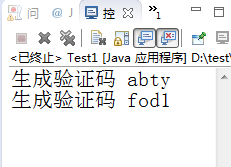1 import java.util.Random; 2 3 4 public class Test1 { 5 6 /** 7 * @param args 8 */ 9 public static void main(String[] args) { 10 // TODO 自动生成的方法存根 11 12 // 方法一: 全部列出 13 String ss=new String("qwertyuiopasdfghjklzxcvbnm1234567890"); 14 15 //随机数实例化 16 Random hh=new Random(); 17 18 //产生字符串ss 字符长度-1的随机数 向前赋值 19 int k=hh.nextInt(ss.length()-1); 20 int l=hh.nextInt(ss.length()-1); 21 int m=hh.nextInt(ss.length()-1); 22 int n=hh.nextInt(ss.length()-1); 23 24 //截取 赋值数与赋值数加一的下标 之间的字符 25 String a=ss.substring(k, k+1); 26 String b=ss.substring(l, l+1); 27 String d=ss.substring(m, m+1); 28 String c=ss.substring(n, n+1); 29 30 //四次截取 分别输出 去换行 31 String e=a+b+d+c; 32 System.out.print("生成验证码 "+e); 33 System.out.println(); 34 35 //方法二 简化 for循环 36 String s=new String("qwertyuiopasdfghjklzxcvbnm1234567890"); 37 Random ran = new Random(); //实例化 38 System.out.print("生成验证码 "); 39 for(int j=0;j<4;j++){ 40 //产生的随机数与实例化后的赋值有关ran. 最大值受字符串length控制需减一 41 //.nextInt();是对ran 采取的方法 42 int r = ran.nextInt(s.length()-1); 43 System.out.print(s.substring(r,r+1)); 44 } 45 46 47 } 48 } 49


搜到
1 package caipiao; 2 3 import java.util.Random; 4 5 public class CaiPiao { 6 7 public static void main(String[ ] args) { 8 // 36选7 9 int[ ] caiPiao = new int[7]; 10 Random rand = new Random(); 11 12 // 生成7个随机数。i代表正在生成第几个数 13 for (int i = 0; i < 7; i++) 14 { 15 // 生成随机数 16 int temp = rand.nextInt(36); 17 18 // 解决重复问题 19 int chongFuCiShu = 0; // 检索数组,记录重复次数 20 for (int j = 0; j < 7; j++) { // 检查是否有重复,有重复就记录chongFuCiShu++; 21 if (temp == caiPiao[j]) { 22 chongFuCiShu++; 23 } 24 } 25 26 if (chongFuCiShu == 0) { 27 caiPiao[i] = temp; 28 } 29 else { 30 i--; 31 } 32 33 } 34 // 显示 35 for (int i = 0; i < caiPiao.length; i++) { 36 System.out.print(caiPiao[i] + " "); 37 } 38 39 } 40 }



